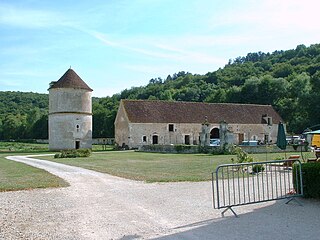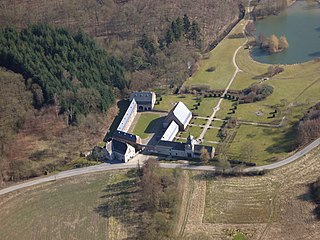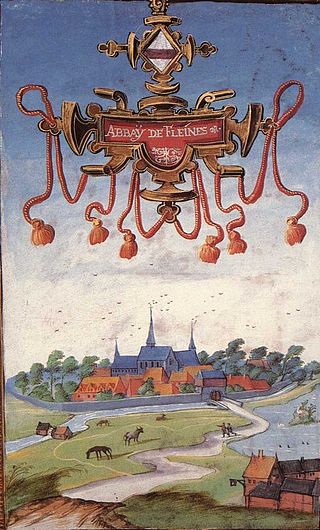
Joan, often called Joan of Constantinople, ruled as Countess of Flanders and Hainaut from 1205 until her death. She was the elder daughter of Baldwin IX, Count of Flanders and Hainaut, and Marie of Champagne.

The County of Hainaut, sometimes spelled Hainault, was a territorial lordship within the medieval Holy Roman Empire that straddled the present-day border of Belgium and France. Its most important towns included Mons, now in Belgium, and Valenciennes, now in France.
John II was Count of Hainaut, Holland, and Zeeland.

Joan of Valois was a Countess consort of Hainaut, Holland, and Zeeland, by marriage to William I, Count of Hainaut. She acted as regent of Hainaut and Holland several times during the absence of her spouse, and she also acted as a political mediator.

The Avesnes family played an important role during the Middle Ages. The family has its roots in the small village Avesnes-sur-Helpe, in the north of France.

Preuilly Abbey was a Cistercian monastery in Égligny in the Seine-et-Marne department, France. It was located about 21 kilometres south-west of Provins and 15 kilometres east of Montereau-Fault-Yonne.

Barbeau Abbey is a former Cistercian monastery in Fontaine-le-Port in the French department of Seine-et-Marne. It was located approximately 10 kilometers northeast of Fontainebleau and 8 kilometers southeast of Melun.

Bonnevaux Abbey is a former Cistercian monastery located in Lieudieu near Villeneuve-de-Marc in the Isère department of France, situated within the Dauphiné region. It is positioned 25 kilometres east of Vienne approximately 6 kilometres south-east of Saint-Jean-de-Bournay, on the northern perimeter of the Forêt de Bonnevaux.

Reigny Abbey was a Cistercian monastery in Vermenton, department of Yonne, Bourgogne, France.

Cambron Abbey was a Cistercian abbey in Cambron-Casteau, in the municipality of Brugelette, Hainaut, Belgium. It was located on the river Blanche, a tributary of the Dender, about 9 km (5.6 mi) to the south-east of Ath. Dissolved in 1782, parts of the abbey still survive as ruins within Pairi Daiza zoo and botanical garden.

Koenigsbruck Abbey otherwise Königsbrück Abbey was a Cistercian nunnery in the Forest of Haguenau, near Leutenheim, Alsace, Bas-Rhin, France, on the River Sauer.

Val-Saint-Lambert Abbey was a Cistercian abbey in the Prince-Bishopric of Liège. It is situated in the Walloon municipality of Seraing, on the right bank of the Meuse, in Belgium, about 13 km (8.1 mi) south-west of Liège. Founded in 1202, the abbey's monks were expelled during the French Revolution. In the 19th century, the building ruins were converted into the Val Saint Lambert crystal factory. The structure is considered to be an important example of Cistercian architecture.

Signy Abbey was a Cistercian abbey located in Signy-l'Abbaye, Ardennes, France. It is located about 65 kilometres (40 mi) northeast of Reims and about 28 kilometres (17 mi) west of Charleville-Mézières on the edge of the Froidmont forest. It was founded on 25 March 1135, the feast day of the Annunciation. It was sold as national property in 1793 and completely demolished. Its library was burned.

Perseigne Abbey is a former Cistercian abbey, formally established in 1145 on land given by William III, Count of Ponthieu, and suppressed in 1791 during the French Revolution. It is located in the north of the Sarthe département near to Neufchâtel-en-Saosnois, on the edge of the Perseigne forest, not far from Alençon.

L’Aumône Abbey is a former Cistercian monastery in the commune of La Colombe, Loir-et-Cher, France, 34 kilometres north of Blois in the Forêt de Cîteaux, part of the Forêt de Marchenoir.

Grandpré Abbey is a former Cistercian abbey located at Faulx-les-Tombes, in the province of Namur, Wallonia, Belgium. The only remains of the abbey are the gatehouse and the attached range at the main entrance, the farm buildings and the mill, once powered by the Samson brook, which crosses the site.

Flines Abbey was a Cistercian nunnery in Flines-lez-Raches near Douai, in the Nord department of France. It was founded in about 1234 by Countess Margaret of Flanders, and served as the burial place not only of Margaret in 1278 but of Margaret's husband William II of Dampierre and their son Guy, Count of Flanders (1304), as well as of Guy's wives Matilda of Béthune (1263) and Isabelle of Luxembourg (1298).
The pagus of Brabant was a geographical region in the early Middle Ages, located in what is now Belgium. It was the first region known to have been called Brabant, and it included the modern capital of Belgium, Brussels. It was divided between the neighbouring counties of Flanders, Hainaut and Louvain (Leuven) in the eleventh century. It was the eastern part, which went to the Counts of Louvain, which kept the name in use, becoming the primary name of their much larger lordship. This led to other regions later being named Brabant - in particular, the French and Dutch-speaking areas east of the Dyle, including Leuven and Wavre, which are still known as "Brabant"; and secondly the province of North Brabant in the Netherlands.
Jean-François Leroux-Dhuys was a French writer and historian.
















